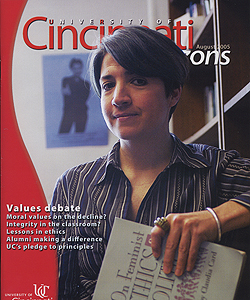Terri Schiavo case fuels debate

Who didn't play the role of ethicist this year as one of the most public medical dilemmas in history unfolded on news outlets worldwide? Terri Schiavo died March 31, 13 days after her feeding tube was ordered removed by the courts. Schiavo, who did not leave written instructions in the event she became disabled, had been in what court-appointed doctors termed a persistent vegetative state since suffering brain damage in 1990.
As one would imagine, the bitter right-to-die dispute became fodder for medical students universally, including those in Dr. Christine McHenry's ethics course at the University of Cincinnati College of Medicine.
"We had a lot of questions raised about when is the appropriate time to use life-sustaining treatment," McHenry says. "Terri's case pushed forward the whole idea of advanced directives. Hopefully it gets society talking."
A living will is the most common type of advanced directive. Others include a no-transfusion directive and a do-not-resuscitate order. Beyond those, there is the durable power of attorney for health care, which allows for the designation of a surrogate medical decision maker. Generally a spouse is the legal surrogate. And if no spouse is available, the state designates someone, usually other family members, to make medical decisions when the patient is incapacitated.
Though Schiavo's case saturated the media, it certainly wasn't the first legal battle over life support. The first occurred in 1976 and involved 21-year-old Karen Ann Quinlan, whom UC's McHenry refers to as the "grandmother of bioethics." Quinlan's family won the right to remove their daughter's respirator a year after she had slipped into a coma as a result of combining too much alcohol with aspirin and Valium at a party.
Quinlan, who remained on a feeding tube, kept breathing after the respirator was unplugged, however, and survived in a comatose state for nearly 10 years. She died in 1985. Her case expanded the patient's right to decline life-sustaining treatment.
The first such case to reach the U.S. Supreme Court was that of Nancy Cruzan. Cruzan was 25 when a 1983 car crash placed her in a vegetative state. A feeding tube similar to Schiavo's kept Cruzan alive for nearly eight years before the court ruled that it could be withdrawn -- establishing the constitutional right of medical self-determination.
Reacting to the Cruzan ruling, Congress passed the Patient Self Determination Act in 1991 that requires health care facilities to ask and provide written information about advanced directives before providing treatment.

 Past Issues
Past Issues